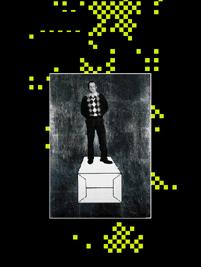| | |  | |  |  | Ritratto generazionale
cm 50x40, acrilico su tela
|  | La parola all’autore
Leonida De Filippi, nasce a Milano nel 1969, dove attualmente vive e lavora. Nel '93 vince il premio Andrea Cascella e nel '95 gli viene conferito il premio per la giovane pittura al Miart (Milano).
A partire dal '92 ha partecipato a numerose mostre collettive. Tra queste ricordiamo, in ordine di tempo: "Art Fence", Rotonda della Besana (MI); "Agravitazionale", Musei Civici, Comune di Rimini (RN); "Giovani artisti europei", Swiss Bank, Londra (Gran Bretagna); "Utopie", Stilo (RC); "Due generazioni di pittori", Monopoli arte cont. (PV); "Ex novo" Brera Cult, Centro internazionale Brera (MI); "Alta Marea", Biennale dei giovani, Chieri (TO); "Arte più critica, Sala dei Templari, Molfetta (BA) - Palazzo della Permanente (MI) - Pinacoteca (BA); 15° Premio Sulmona, Sulmona (AQ); "Triplozero", Nuovi indirizzi della giovane arte in Italia, Antichi arsenali, Amalfi (SA); "Relazioni luminose", Museo G.B. Rubini, Romano di Lombardia (BG); "Figurazione a Milano, dal Secondo Dopoguerra a oggi", La Posteria (MI); "Sui generis", PAC, Padiglione d'arte contemporanea (MI). Tra le mostre personali ricordiamo invece: Monopoli Arte Contemporanea (PV); Bianca Pilat (MI); Nuova Artesegno (UD); Seoul Art Center Museum, Seoul.
A word from the artist
Leonida De Filippi was born in Milan in 1969, where he currently lives and works. In ’93 he won the Andrea Cascella prize, in ’95 the Miart (Milan) young painter prize.
Starting off from ’92 he has taken part in numerous collective exhibitions. Among these we recall, in order of time: “Art Fence”, Rotonda della Besana (MI); “Agravitazionale”, Civic Museums, Comune di Rimini (RN); “ Young European Artists”, Swiss Bank, London (UK); “Utopias”, Stilo (RC); “Two generations of painters”, Monopoli arte cont. (PV); “Ex novo” Brera Cult, Brera International Centre (MI); “Alta Marea”, young persons’ Biennale, Chieri (TO); “Art and art critiscism, Sala dei Templari, Molfetta (BA) - Palazzo della Permanente (MI) - Pinacoteca (BA); 15° Premio Sulmona, Sulmona (AQ); “Triplozero”, New directions of young art in Italy, Antichi arsenali, Amalfi (SA); “Luminous relations”, Museo G.B. Rubini, Romano di Lombardia (BG); “Figurations in Milan , from the postwar period to the present day”, La Posteria (MI); “Sui generis”, PAC, Padiglione d’arte contemporanea (MI).
Among his one-man shows we recall: Monopoli Arte Contemporanea (PV); Bianca Pilat (MI); Nuova Artesegno (UD); Seoul Art Center Museum, Seoul.
|  | | |  | La parola al critico
I volti e i corpi delle tele di Leonida De Filippi ricostruiscono il ritratto ideale di una generazione. Immagini veloci, piatte, da fruire e consumare in velocità secondo i ritmi frenetici della quotidianità. Icone del contemporaneo per le quali l'artista si è ispirato alla tradizione, i disegni su fondo bianco di André Rodin, e alla realtà che lo circonda, eventi della storia e della cronaca di tutti i giorni come la modificazione genetica, la necessità di produrre armi e continuo benessere distruggendo il pianeta. Pittori, scultori, critici, scenografi, scrittori sono i soggetti delle tele serigrafate, colti nella normalità dall'immediatezza della macchina digitale. Le figure ottenute con la fotografia e successivamente trasportate sulla tela corrispondono al desiderio di restituire la meccanicità, la freddezza e l'apparente qualità inferiore dell'immagine che, in realtà, richiede un lungo e meticoloso processo di realizzazione tecnica. La quotidianità che l'artista rappresenta restituisce una lettura veloce, piatta, che non impedisce, tuttavia, riflessioni sulla poetica di un mondo che vorrebbe raggiungere bellezza e perfezione inseguendo la chimera della scienza e della tecnologia. Il margine d'imprevisto per Leonida De Filippi è l'elemento scultoreo, esterno alla tela, il cui significato simbolico allude alla forzatura dell'uomo rispetto alla natura: le piccole sculture sono infatti protuberanze fitomorfe ma hanno punte aguzze e colori violenti e artificiali. Nell'ultima serie di opere, delle quali una è riprodotta in copertina, i personaggi stanno sopra una scatola contenitore, simbolo di uno scrigno volutamente poco prezioso in cui è racchiuso il segreto del mondo.
Rachele Ferrario
A word from the critic
The faces and the bodies of Leonida De Filippi’s canvases reconstruct the ideal portrait of a generation. Speedy, flat images, to be used and consumed at great speed according to the frenetic rhythms of daily life. Icons of the contemporary for which the artist drew inspiration from tradition, the drawings on a black background by André Rodin, and the reality that surrounds him, events from history and from the every day such as genetic modification, the need for arms production and the continuing affluence that is destroying the planet. Painters, sculptors, critics, theatre designers, writers are the subject of screenprinted canvases, caught in normality by the immediacy of the digital camera. The figures obtained by photography and after that transposed onto canvas correspond to the desire to restore the mechanical nature, the coldness and the apparent inferior quality of the image that, in actual fact is the result of a long and meticulous technical process. The daily events represented by the artist restore a speedy, flat reading that does not all the same impede reflections on the poetics of a world that wishes to attain beauty and perfection pursuing the chimera of science and technology.
The unexpected margin for Leonida De Filippi is the sculptural element, outside the canvas, the symbolic meaning of which alludes to man’s straining of nature: the small sculptures are in fact phytomorphous protuberances yet they have sharp points and violent and artificial colours. In the last series of works, one of which is reproduced on the cover of this magazine, the characters are on top of a box-container, symbol of an intentionally non-precious jewel box that encloses the secret of the world.
Rachele Ferrario
| |